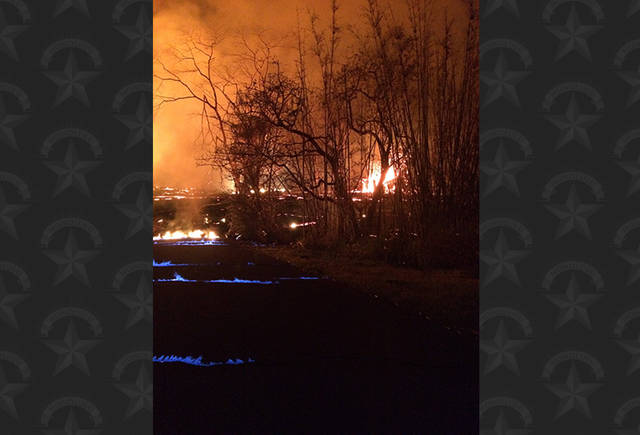Kilauea glows with blue light from methane flame


ASSOCIATED PRESS
This photo from video from the U.S. Geological Survey shows blue burning flames of methane gas erupting through cracks on Kahukai Street in the Leilani Estates neighborhood of Pahoa on the island of Hawaii early Wednesday. (U.S. Geological Survey image via AP)

COURTESY USGS
Blue burning flames from methane gas are observed in the cracks on Kahukai Street in the Leilani Estates subdivision early Wednesday.



Blue flames from burning methane are the latest natural phenomena being seen at the eruption of the Kilauea volcano in Hawaii.
Nighttime photos released today by the U.S. Geological Survey show the flames spouting from cracks in the pavement in the Leilani Estates neighborhood where the volcano has been gushing lava on the Big Island for the past three weeks.
The volcano produces methane when hot lava buries and burns plants and trees.
“The methane gas will flow through the ground, through the cracks that are already existing, and will come up wherever there’s a place for them to come up,” said Wendy Stovall, a scientists with the U.S. Geological Survey.
The methane can seep through cracks several feet away from the lava. It can also cause explosions when it’s ignited while trapped underground. These blasts can toss blocks several feet away, Stovall said.
Hawaii County has ordered about 2,000 people to evacuate from Leilani Estates and surrounding neighborhoods since the eruption began on May 3.
Don't miss out on what's happening!
Stay in touch with breaking news, as it happens, conveniently in your email inbox. It's FREE!
The volcano has opened more than 20 vents in the ground that have released lava, sulfur dioxide and steam. The lava has been pouring down the flank of the volcano and into the ocean miles away.
The eruption has destroyed 50 buildings, including about two dozen homes. One man was seriously injured in the leg after being hit by a flying piece of lava.
Stovall said lava spatter from one of the vents was forming a wall that was helping protect a nearby geothermal plant.
Lava from that vent was shooting further into the air and producing the highest lava wall of all the vents, which was blocking molten rock from flowing north toward the plant.



